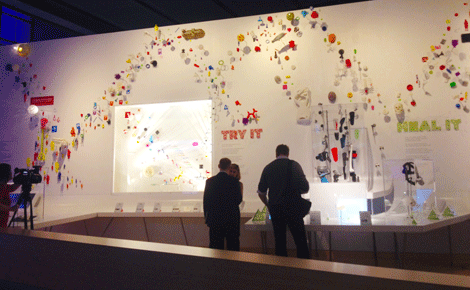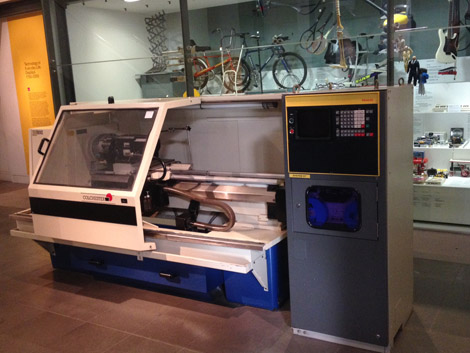
The Science Museum’s new 3D printing exhibition
Nestled amongst some of the most important historic vehicles, machines and devices in London’s Science Museum is a solitary CNC lathe.
Its tape-driven computer interface resembling a sullen ‘face’, it sits in a quiet corner, being tended to by the cleaning staff of the museum who wipe it over with a damp cloth.
Its history is colourful enough: computer numerical control was originally designed by the US military so that arms production could still continue should a limited workforce be holed up in underground bunkers should the Cold War go tits up.
Today, advanced versions of this pioneering device drive modern manufacturing and R&D, yet it sits ignored by the throngs of school children as they sprint past it to look at the Science Museum’s latest exhibit, 3D: printing the future.

The loneliest CNC machine
It’s not the first exhibition covering 3D printing – in July the Design Museum opened its Future Is Here exhibit; last year saw the opening of the 3D Printshow in London before it gallivanted off to Paris and beyond.
Even antiquated manufacturing trade shows have shaken off the burden of workmen’s tools like a hot-footing Billy Elliot to embrace the bright new world of spluttering plastics.
3D printing is a draw that no museum or show today can be without – even DEVELOP3D Live’s most attended talks this year covered the topic.
It’s an amazing technology, a multi-faceted process that will allow mankind to make things never before allowed by conventional means, but when our grandchildren visit the Science Museum will they give a shit?
If a machine that spawned the new age of digital manufacturing sits unloved, un-cherished, receiving the mechanical equivalent of a sponge-bath in a retirement home, where will this fervour for 3D printing drop off?
The next generation are already lapping up Raspberry Pi like actual cake, never looking up from their smart phones and are allegedly chomping at the bit to make things.
Magazine features, news programmes and even the One Show are full of men you wouldn’t have previously left your children alone in a room with telling you that 3D printing isn’t just an amazing manufacturing solution of the future, but the technology that our children will easily embrace and create a new world from.
Well over 12 million people worldwide have bought Minecraft – a sort of virtual building block world –many of its best and brightest include young kids.
These creations can now be manipulated by the good people at Printcraft to make an .STL file and 3D print it – hence an easy access CAD solution and the golden path down to which we can all operate and use a 3D printer.
However, there is a flipside to this expectant analysis: elsewhere 40 million people are online actively blowing off virtual heads playing Call of Duty.
The Daily Mail would have us all donning Kevlar body armour if this approach to correlation were an accurate reflection of the masses taking up 3D printing.
The real excitement lies in the still experimental stages of 3D printing for manufacturing.
The work being done by one of the contributors to the Science Museum’s show, Professor Richard Hague from The University of Nottingham, for example, on developing software and processes for how metals can be printed alongside plastics.
Producing entire items in one build without need for assembly is much more exciting and gives a more realistic result than simply plastic figurines or ‘artwork’ (i.e. tat).
Yet how do you express this burgeoning prowess to an audience at a museum without running banks of machines or giving in-depth technical knowledge that can both equally overheat and overwhelm a visitor in a short period?
You don’t. Instead the process is brought down to base levels – plastic customisations, figurines, interesting shapes and a row of jittering Ultimaker printers.
The Science Museum’s exhibition is a literal rainbow of colour and creativity, over 600 objects plastered across a wall as a visual expression of printer output.
Videos explain how different technologies upscale this to wider purposes, but there is little else of detail to cloud the message.
Prof. Hague has even produced a concept model of a bionic arm to show how future developments might take shape, alongside other bodily replacements such as teeth and ears.
The exhibition is as good as any of the others – it will inspire and educate those that are not already in awe of what 3D printing can do – but for all the pomp and colour it is merely another process.
For the CNC lathe in the adjoining room, stolidly squatting behind an attention-seeking trans-Antarctic expedition snow cat, the future will still have a need for subtractive manufacturing.
Which incarnation of the 3D printer will join it in the halls of the Museum? We will have to wait and see, although whichever machine, it is destined to be much more memorable.






